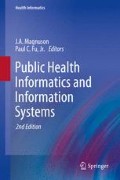Abstract
The public health landscape is undergoing profound changes, including rapid advances in technology, increasing use of electronic health records, and health reform. Improving population health requires knowledge and skills in managing and working within the adaptive complexity of underlying societal structures and functions. These advances in technology, and profound changes within these structures and functions, introduce enormous opportunities for creating efficiencies and economies of scale, not simply for improving public health practice, but for learning as well. Finding informatics solutions to cross-cutting information needs, while solving complex health problems, requires cross-disciplinary education, research, and practice.
Approaches to overcoming these challenges should address the complexity of problems within both the work and learning environments. These problem-based approachevs build skills in collaborative problem solving, critical thinking, systems thinking and lifelong learning. This chapter discusses case-based learning (CBL) as one of the methods for problem-based learning (PBL) and is aimed at the student of public health informatics (PHI) exploring this topic for the first time. The chapter concludes with a student exercise developed for fellows in the CDC Public Health Informatics Fellowship Program.
Access this chapter
Tax calculation will be finalised at checkout
Purchases are for personal use only
References
Tolentino H, Sridhar P, Franzke L. “Introduction to public health informatics”. Public Health Informatics Fellowship Program Summer Orientation. Summer 2012.
Sterman JD. Learning from evidence in a complex world. Am J Public Health. 2006;96(3):505–14.
Parrish RG. Measuring population health outcomes. Prev Chronic Dis. 2010;7(4):A71.
Committee on Public Health Strategies to Improve Health, and Institute Of Medicine. For the public’s health: the role of measurement in action and accountability. Washington, DC: National Academy Press; 2011.
Kindig D, Stoddart G. What is population health? J Public Health. 2003;93:380–3.
Heeks R, Bhatnagar S. Understanding success and failure in information age reform. In: Reinventing government in the information age: international practice in IT-enabled public sector reform. London: Routledge; 1999. p. 49–75.
De Savigny D, Taghreed A. Systems thinking for health systems strengthening. Geneva: World Health Organization; 2009.
Taylor RS. Value‐added processes in the information life cycle. J Am Soc Inf Sci. 1982;33(5):341–6.
Plsek PE, Greenhalgh T. The challenge of complexity in health care. BMJ. 2001;323(7313): 625–8.
Savery JR. Overview of problem-based learning: definitions and distinctions. Interdiscip J Probl-Based Learn. 2006;1(1):3.
Barrows HS, Kelson AM. “Problem-based learning: a total approach to education.” monograph. Springfield: Southern Illinois University School of Medicine; 1993.
Barrows HS. A taxonomy of problem-based learning methods. Med Educ. 1986;20(6):481–6.
Ericsson KA. Deliberate practice and the acquisition and maintenance of expert performance in medicine and related domains. Acad Med. 2004;79(10):S70–81.
Tolentino H, Sridhar RP, Penney R, Laura F, Vipat K, Denise K. “Development of a problem solving framework for public health informatics.”2011 Public Health Informatics Conference. Centers for Disease Control and Prevention. Hyatt Regency Hotel, Atlanta. 24 August 2011. Poster presentation.
Bloom BS, et al. Taxonomy of educational objectives: handbook I: cognitive domain, vol. 19. New York: David McKay; 1956. p. 56.
Anderson LW, Krathwohl DR, Bloom BS. A taxonomy for learning, teaching, and assessing. New York: Longman; 2005.
CDC Public Health Informatics Fellowship Program. Available at: http://www.cdc.gov/PHIFP. Last accessed 14 Mar 2013.
CDC Epidemic Intelligence Service Fellowship Program. Available at: http://www.cdc.gov/EIS. Last accessed 22 Mar 2013.
Tolentino H, Magnuson JA, Arun S. “Challenges in implementing electronic lab reporting in State Oz”. Public Health Informatics Fellowship Program Summer Orientation. Summer 2012. Case Study.
Raths D. Meaningful change coming to public health. Healthcare Inf. 2011;28(6):69–72.
Naumes W, Naumes MJ. The art & craft of case writing. Armonk: ME Sharpe Inc; 2011.
Regenstrief Institute. Logical Observation Identifiers Names and Codes (LOINC®). 2013. Available at: http://loinc.org/. Last accessed 14 June 2013.
International Health Terminology Standards Development Organisation. SNOMED CT. Available at: http://www.ihtsdo.org/snomed-ct/. Last accessed 14 June 2013.
Centers for Disease Control and Prevention (CDC). Electronic reporting of laboratory data for public health: meeting report and recommendations, Health Information and Surveillance Systems Board (HISSB). 1997. Available at: http://stacks.cdc.gov/ObjectView?pid=cdc%3A11377&dsid=DS1&mimeType=application%2Fpdf. Last accessed 14 June 2013.
Pinner RW, Jernigan DB, Sutliff SM. Electronic laboratory-based reporting for public health. Mil Med. 2000;165(7 Suppl 2):20.
Overhage JM, Grannis S, McDonald CJ. A comparison of the completeness and timeliness of automated electronic laboratory reporting and spontaneous reporting of notifiable conditions. Am J Public Health. 2008;98(2):344–50.
Magnuson JA. National electronic laboratory reporting snapshot survey. Available at: http://www.coast2coastinformatics.com/2011NationalELRSurvey-DataSummary.pdf. Last accessed 30 Mar 2013.
Health Information and Management Systems Society (HIMSS). HIMSS Meaningful Use One Source. Available at: http://www.himss.org/meaningfuluse?navItemNumber=13303. Last accessed 30 Mar 2013.
National Electronic Disease Surveillance System Working Group. National Electronic Disease Surveillance System (NEDSS): a standards-based approach to connect public health and clinical medicine. J Public Health Manag Pract. 2001;7(6):43–50.
Centers for Disease Control and Prevention (CDC). Progress in improving state and local disease surveillance–United States, 2000–2005. 2005;54(33):822–25. Available at: http://www.cdc.gov/mmwr/preview/mmwrhtml/mm5433a3.htm. Last accessed 30 Mar 2013.
Case Supplementary Reading
Health Level Seven International HL7®. Available at: http://www.hl7.org/. Last accessed 14 June 2013.
HL7® Tools and Resources Directory (Australia). Available at: http://www.hl7.com.au/HL7-Tools.htm Last accessed 14 June 2013.
Centers for Disease Control and Prevention Electronic Laboratory Reporting (ELR). Available at: http://www.cdc.gov/ehrmeaningfuluse/elr.html. Last accessed 14 June 2013.
Centers for Disease Control and Prevention (CDC). Electronic Reporting of Laboratory Information for Public Health: Summary of Meeting Proceedings. January 7–8, 1999. Atlanta Ga.: Centers for Disease Prevention; 2000.
Author information
Authors and Affiliations
Corresponding author
Editor information
Editors and Affiliations
Rights and permissions
Copyright information
© 2014 Springer-Verlag London
About this chapter
Cite this chapter
Tolentino, H., Sangareddy, S.R.P., Pepper, C., Magnuson, J.A. (2014). Case-Based Learning in Public Health Informatics. In: Magnuson, J., Fu, Jr., P. (eds) Public Health Informatics and Information Systems. Health Informatics. Springer, London. https://doi.org/10.1007/978-1-4471-4237-9_25
Download citation
DOI: https://doi.org/10.1007/978-1-4471-4237-9_25
Published:
Publisher Name: Springer, London
Print ISBN: 978-1-4471-4236-2
Online ISBN: 978-1-4471-4237-9
eBook Packages: MedicineMedicine (R0)

